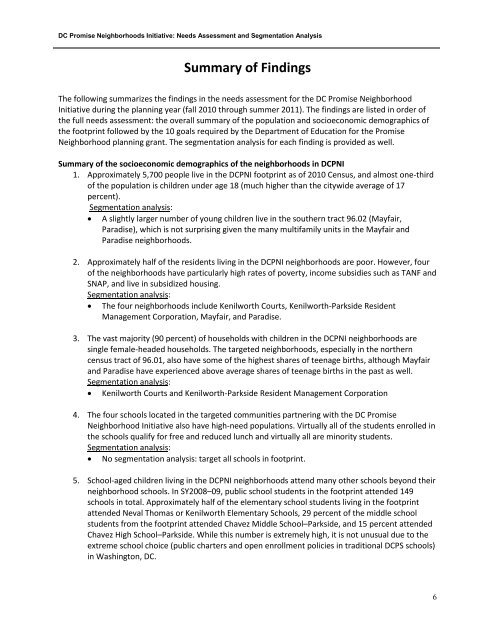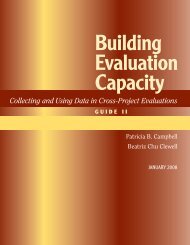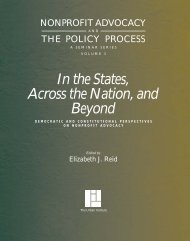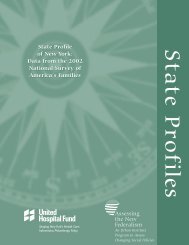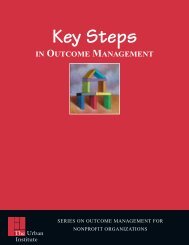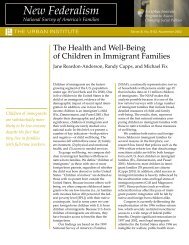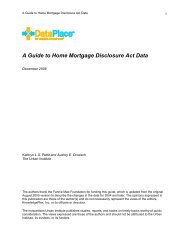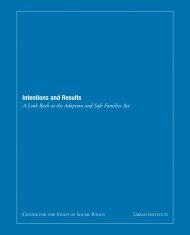DC Promise Neighborhood Initiative: Needs ... - Urban Institute
DC Promise Neighborhood Initiative: Needs ... - Urban Institute
DC Promise Neighborhood Initiative: Needs ... - Urban Institute
Create successful ePaper yourself
Turn your PDF publications into a flip-book with our unique Google optimized e-Paper software.
<strong>DC</strong> <strong>Promise</strong> <strong>Neighborhood</strong>s <strong>Initiative</strong>: <strong>Needs</strong> Assessment and Segmentation AnalysisSummary of FindingsThe following summarizes the findings in the needs assessment for the <strong>DC</strong> <strong>Promise</strong> <strong>Neighborhood</strong><strong>Initiative</strong> during the planning year (fall 2010 through summer 2011). The findings are listed in order ofthe full needs assessment: the overall summary of the population and socioeconomic demographics ofthe footprint followed by the 10 goals required by the Department of Education for the <strong>Promise</strong><strong>Neighborhood</strong> planning grant. The segmentation analysis for each finding is provided as well.Summary of the socioeconomic demographics of the neighborhoods in <strong>DC</strong>PNI1. Approximately 5,700 people live in the <strong>DC</strong>PNI footprint as of 2010 Census, and almost one-thirdof the population is children under age 18 (much higher than the citywide average of 17percent).Segmentation analysis: A slightly larger number of young children live in the southern tract 96.02 (Mayfair,Paradise), which is not surprising given the many multifamily units in the Mayfair andParadise neighborhoods.2. Approximately half of the residents living in the <strong>DC</strong>PNI neighborhoods are poor. However, fourof the neighborhoods have particularly high rates of poverty, income subsidies such as TANF andSNAP, and live in subsidized housing.Segmentation analysis: The four neighborhoods include Kenilworth Courts, Kenilworth-Parkside ResidentManagement Corporation, Mayfair, and Paradise.3. The vast majority (90 percent) of households with children in the <strong>DC</strong>PNI neighborhoods aresingle female-headed households. The targeted neighborhoods, especially in the northerncensus tract of 96.01, also have some of the highest shares of teenage births, although Mayfairand Paradise have experienced above average shares of teenage births in the past as well.Segmentation analysis: Kenilworth Courts and Kenilworth-Parkside Resident Management Corporation4. The four schools located in the targeted communities partnering with the <strong>DC</strong> <strong>Promise</strong><strong>Neighborhood</strong> <strong>Initiative</strong> also have high-need populations. Virtually all of the students enrolled inthe schools qualify for free and reduced lunch and virtually all are minority students.Segmentation analysis: No segmentation analysis: target all schools in footprint.5. School-aged children living in the <strong>DC</strong>PNI neighborhoods attend many other schools beyond theirneighborhood schools. In SY2008–09, public school students in the footprint attended 149schools in total. Approximately half of the elementary school students living in the footprintattended Neval Thomas or Kenilworth Elementary Schools, 29 percent of the middle schoolstudents from the footprint attended Chavez Middle School–Parkside, and 15 percent attendedChavez High School–Parkside. While this number is extremely high, it is not unusual due to theextreme school choice (public charters and open enrollment policies in traditional <strong>DC</strong>PS schools)in Washington, <strong>DC</strong>.6


